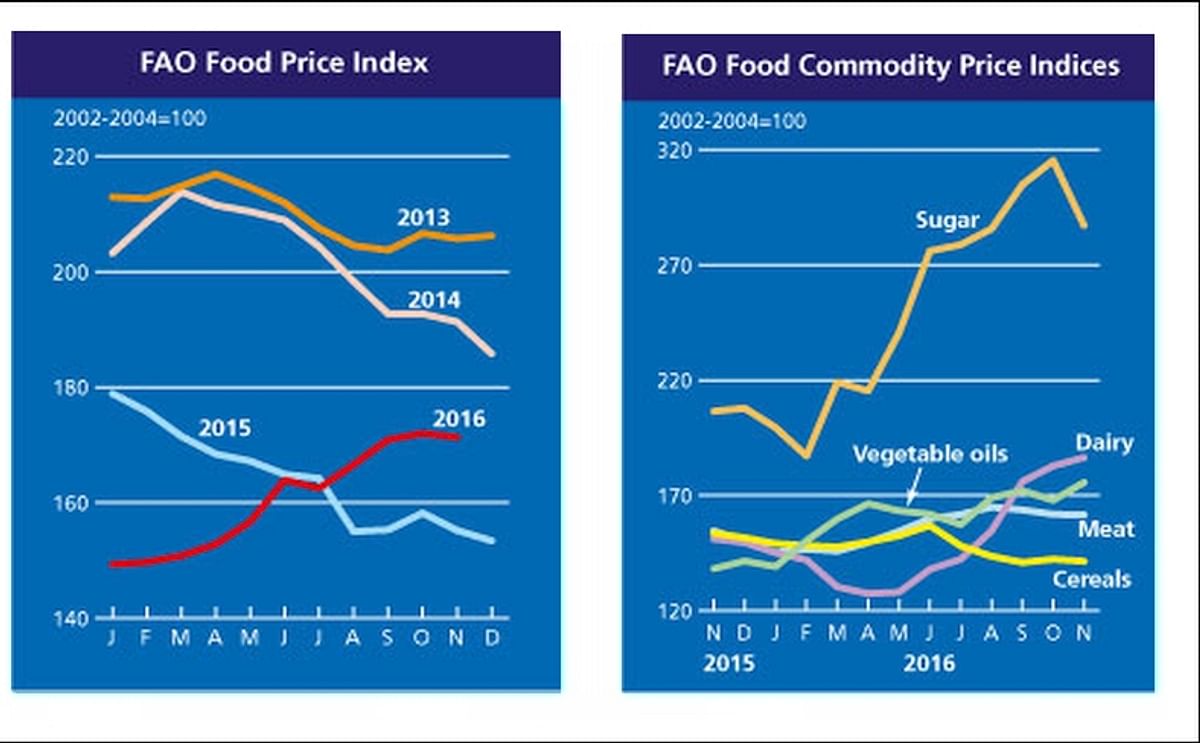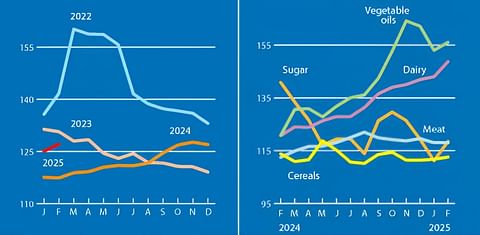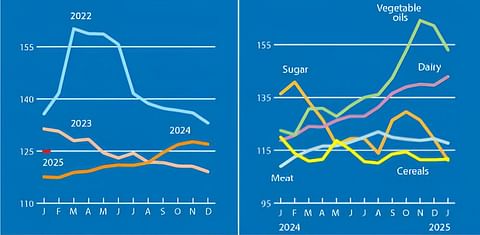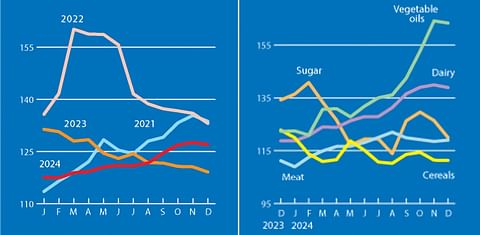The month-to-month small decline in November marked a departure from an almost uninterrupted rising trend in the food price Index since the start of 2016.
FAO Food Price Index down slightly in November 2016

The FAO Food Price Index (FFPI) averaged 171.3 points in November 2016, only 0.4 percent below its October level, but still 10.4 percent higher than in November 2015. The month-to-month small decline marked a departure from an almost uninterrupted rising trend in the Index since the start of the year. November’s easing was driven by a sharp dip in sugar prices, which more than offset a strong rebound in the prices of vegetable oils.
The FAO Cereal Price Index averaged 141.4 points in November, down 0.6 percent from October and as much as 12 points (7.9 percent) below the previous year’s level. The strengthening US dollar and ample supplies contributed to the generally weak tone lingering in cereal markets. Good harvest prospects in Argentina and Australia weighed on wheat quotations. International rice prices remained close to multi-year lows reached in October, amid relentless pressure applied by new-crop arrivals and sluggish demand.
The FAO Vegetable Oil Price Index rose to 175.6 in November, up 7.6 points (or 4.5 percent) from October and marking the highest level since August 2014. The strong rebound was primarily driven by palm oil, whose prices strengthened amid lower than anticipated production in Southeast Asia and prospects of continued global supply tightness. Soyoil quotations also appreciated, reflecting firm global import demand coupled with below-potential crushings in South America. Prospects of rising demand for vegetable oils from the biodiesel sector also lent support to prices.
The FAO Dairy Price Index averaged 186.4 points in November, up 3.6 points (1.9 percent) from October. Quotations rose for Whole Milk Powder (WMP) in particular; butter also firmed. Sustained import demand by markets in the Middle East and North Africa, plus China, combined with limited availability from New Zealand, the main world supplier, led to WMP prices jumping by 9 percent. For butter, the market tightened due to rising domestic usage in the EU and the United States and robust import demand elsewhere. Cheese and Skimmed Milk Powder supply and demand were well-balanced, and prices remained steady.
The FAO Meat Price Index averaged 161.5 points in November, essentially unchanged from its revised value for October. Lower prices for ovine meat, pigmeat and chicken meat were counter balanced by a rise in bovine meat quotations. Adequate availability of pigmeat within the EU, ahead of the peak season for ovine meat production in Oceania and a continued downward drift in chicken meat prices contributed to quotations for these commodities falling back somewhat. Conversely, tighter domestic supplies of bovine meat in Australia caused export quotations from this source to increase.
The FAO Sugar price index averaged 287.1 points in November, down nearly 28 points (8.9 percent) from October and marking the first decline after six consecutive monthly increases. The fall in international sugar prices was largely imputable to a weakening of the Brazilian currency (Real) with respect to the United States Dollar, which stimulated sugar exports from Brazil, the world’s largest sugar producer and exporter. Reports of a higher than expected harvest in the Centre South, Brazil’s main producing region, also helped to pressure sugar prices downward.
The FAO Cereal Price Index averaged 141.4 points in November, down 0.6 percent from October and as much as 12 points (7.9 percent) below the previous year’s level. The strengthening US dollar and ample supplies contributed to the generally weak tone lingering in cereal markets. Good harvest prospects in Argentina and Australia weighed on wheat quotations. International rice prices remained close to multi-year lows reached in October, amid relentless pressure applied by new-crop arrivals and sluggish demand.
The FAO Vegetable Oil Price Index rose to 175.6 in November, up 7.6 points (or 4.5 percent) from October and marking the highest level since August 2014. The strong rebound was primarily driven by palm oil, whose prices strengthened amid lower than anticipated production in Southeast Asia and prospects of continued global supply tightness. Soyoil quotations also appreciated, reflecting firm global import demand coupled with below-potential crushings in South America. Prospects of rising demand for vegetable oils from the biodiesel sector also lent support to prices.
The FAO Dairy Price Index averaged 186.4 points in November, up 3.6 points (1.9 percent) from October. Quotations rose for Whole Milk Powder (WMP) in particular; butter also firmed. Sustained import demand by markets in the Middle East and North Africa, plus China, combined with limited availability from New Zealand, the main world supplier, led to WMP prices jumping by 9 percent. For butter, the market tightened due to rising domestic usage in the EU and the United States and robust import demand elsewhere. Cheese and Skimmed Milk Powder supply and demand were well-balanced, and prices remained steady.
The FAO Meat Price Index averaged 161.5 points in November, essentially unchanged from its revised value for October. Lower prices for ovine meat, pigmeat and chicken meat were counter balanced by a rise in bovine meat quotations. Adequate availability of pigmeat within the EU, ahead of the peak season for ovine meat production in Oceania and a continued downward drift in chicken meat prices contributed to quotations for these commodities falling back somewhat. Conversely, tighter domestic supplies of bovine meat in Australia caused export quotations from this source to increase.
The FAO Sugar price index averaged 287.1 points in November, down nearly 28 points (8.9 percent) from October and marking the first decline after six consecutive monthly increases. The fall in international sugar prices was largely imputable to a weakening of the Brazilian currency (Real) with respect to the United States Dollar, which stimulated sugar exports from Brazil, the world’s largest sugar producer and exporter. Reports of a higher than expected harvest in the Centre South, Brazil’s main producing region, also helped to pressure sugar prices downward.
¿Te gustaría recibir noticias como esta por correo electrónico? ¡Únete y suscríbete!
NEW! Join Our BlueSky ¡Canal para actualizaciones periódicas!
Empresa Destacada
Contenido Patrocinado
Contenido Patrocinado
Contenido Patrocinado
Contenido Patrocinado
Contenido Patrocinado










